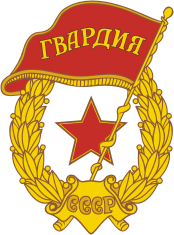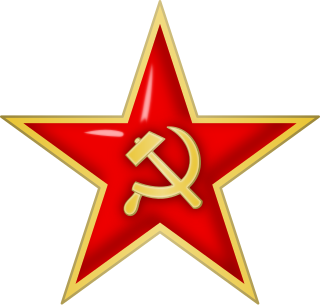Related Research Articles

The Battle of Vuosalmi – the main bulk of it – lasted from July 4 to July 17, 1944. It was fought during the Continuation War (1941–1944), a part of World War II, between Finland and the Soviet Union.
The 16th Army was a Soviet field army active from 1940 to 1945.

The 3rd Guards Volnovakha Red Banner Order of Suvorov Motor Rifle Division was a division of the Soviet Army from 1957 to around 1992. It traced its history from the highly decorated 3rd Guards Rifle Division of World War II. 3rd Guards Rifle Division was formed from the 153rd Rifle Division.
The 31st Army was a field army of the Red Army during the Second World War.
The 32nd Army was a formation of the Soviet Army during World War II. The army was formed twice during the war, disbanded as part of the post-war demobilization and then reformed in 1969 to protect the Soviet-Chinese border.

The 5th Shock Army was a Red Army field army of World War II. The army was formed on 9 December 1942 by redesignating the 10th Reserve Army. The army was formed two times prior to this with neither formation lasting more than a month before being redesignated.
This is the order of battle for the Leningrad Strategic Defensive covering the period 10 July to 30 September 1941.
The 11th Guards Rifle Division was a rifle division of the Red Army during the Great Patriotic War. It was disbanded in 1946.
The 48th Army was a field army of the Soviet Red Army, active from 1941 to 1945. The army was first formed in August 1941 and fought in the Leningrad Strategic Defensive Operation. The army suffered heavy losses and was disbanded in early September. Its remnants were moved to the 54th Army. Reformed in April 1942 on the Bryansk Front, the army fought in the Maloarkhangelsk Offensive in the winter of 1943. It was sent to the Central Front in March and defended the northern face of the Kursk Bulge. During the summer, it fought in Operation Kutuzov and the Chernigov-Pripyat Offensive. From November, the army fought in the Gomel-Rechitsa Offensive. The army fought in Operation Bagration from June 1944. During the offensive, the army captured Zhlobin and Bobruisk and was on the Narew by early September. During early 1945, the army fought in the East Prussian Offensive and ended the war in East Prussia during May. The army was transferred to Poland in July 1945 and its headquarters was used to form the Kazan Military District in September.
The 109th Rifle Division was a Red Army infantry division that was formed three times, briefly in 1939, during 1942, and again from 1942-45. The first formation of the division was converted to a mechanized division after about nine months. Its second formation served for six months in 1942 in the defense of the fortress of Sevastopol, in the southern sector of the siege lines. After being destroyed there in July, a third division was formed by re-designating an existing rifle division near Leningrad in August, and it successfully held its positions for nearly a year and a half, in spite of shortages of food and supplies due to the German/Finnish siege. The 109th then participated in the offensive that drove the Germans away from the city in early 1944, helped drive Finland out of the war, and then joined the offensive along the Baltic coast towards Germany. This third formation compiled an admirable record of service, but was disbanded in 1946.
The 120th Rifle Division was an infantry division of the Red Army, formed three times. Its first formation became the 6th Guards Rifle Division for its actions in the Yelnya Offensive. Its second formation became the 69th Guards Rifle Division for its actions in the Battle of Stalingrad. The division was reformed a third time in late April 1943. It was disbanded "in place" with the Central Group of Forces in the summer of 1945.
The 64th Guards Rifle Division was created on January 19, 1943 from the 327th Rifle Division, in recognition of that division's distinguished combat record in the Second Siniavino Offensive and Operation Iskra. It was one of a relatively small number of formations raised to Guards status in the northern sector of the Soviet-German Front. As such, it was employed as an assault division in the subsequent fighting, particularly in the final defeat of the German forces before Leningrad, and the final offensive against Finland. The division ended the war in Lithuania, helping to contain the enemy forces trapped in the Courland Pocket, and went on to serve well into the postwar era, still in the Leningrad/St. Petersburg area.
The 378th Rifle Division was an infantry division of the Red Army that began forming in August 1941 in the Siberian Military District, before being sent to the vicinity of Leningrad, where it spent most of the war. The soldiers of this division fought until early 1944 to break the siege and drive off the besieging German forces, distinguishing themselves in the liberation of Novgorod. Finally, the division was redeployed to advance into the Baltic states in 1944 and into East Prussia in the winter of 1945. As the war was ending the 378th was disbanded to provide replacements for other divisions. Nevertheless, it had compiled a very creditable combat record for any rifle division.
The 319th Rifle Division was first formed in December 1941, as a standard Red Army rifle division, in the Moscow Military District, but after a month was redesignated as the 2nd formation of a pre-war division that had been destroyed and disbanded. Another 319th was formed in the summer of 1942 in the North Caucasus Military District while the German offensive was threatening the Soviet oilfields near Baku. This formation had a short and undistinguished career, seeing little combat, and was disbanded in December. A third and final 319th was formed in the autumn of 1943 in the northern part of the front. This unit gave very creditable service for the duration of the war, distinguishing itself in the fighting through the Baltic states, and completing its combat path in East Prussia. It continued to serve briefly into the postwar period.
The 56th Rifle Division was an infantry division of the Red Army and later the Soviet Army of the Soviet Union, formed three times.

The 70th Rifle Division was an infantry division of the Red Army and briefly of the Soviet Army, formed twice.
The 382nd Rifle Division was raised in 1941 as an infantry division of the Red Army, and served for the duration of the Great Patriotic War in that role. It began forming on August 10 in the Siberian Military District. It joined the fighting front in December with the new 59th Army along the Volkhov River. Apart from a few weeks in 1944 the division served in either the Volkhov Front or the Leningrad Front for the entire war. It suffered horrendous casualties after being encircled in the swamps and forests near Lyuban and was severely understrength for many months afterwards while serving on a relatively quiet front. It remained in the line in the dismal fighting near Leningrad until early 1944 with little opportunity to distinguish itself, and the division did not finally earn a battle honor until late January, 1944, during the Leningrad–Novgorod Offensive. Following this the division was moved to the Karelian Isthmus and entered the summer offensive against Finland in the reserves of Leningrad Front before being assigned to the 23rd Army. Following the Finnish surrender it was redeployed westward, helping to mop up pockets of enemy forces in the Baltic states in early 1945. The 382nd ended the war in Latvia, helping to contain and reduce the German forces trapped in the Courland Pocket, and was officially disbanded in February, 1946.
The 23rd Guards Rifle Division was reformed as an elite infantry division of the Red Army in March, 1942, based on the 1st formation of the 88th Rifle Division, and served in that role until after the end of the Great Patriotic War. It was one of just two Guards divisions to be formed in the far north, the 10th Guards being the other. It continued to serve in Karelian Front, where it was formed, until October when it was railed south to join the 1st Shock Army of Northwestern Front; it would remain in that Army until nearly the end of 1944. Over the next several months it took part in the dismal fighting around the Demyansk salient until it was evacuated by the German II Army Corps in March, 1943. During the rest of the year the division continued battling through the forests and swamps south of Lake Ilmen, occasionally under command of the 14th Guards Rifle Corps, until the Leningrad-Novgorod Offensive began in late January, 1944. The 23rd Guards took part in the liberation of Staraya Russa in mid-February and went on to win a battle honor about a week later at Dno. 1st Shock Army closed up to the German Panther Line south of Lake Peipus during the spring and then helped break through it at the start of the Baltic Campaign in July. For its part in the liberation of Ostrov the division was awarded the Order of the Red Banner before gradually advancing through Latvia towards Riga, which it helped to liberate in October. By now it was in the 12th Guards Rifle Corps which was transferred in late November to the 3rd Shock Army in 1st Belorussian Front. The 23rd Guards would remain under these commands for the duration of the war, advancing across Poland and eastern Germany into Berlin in 1945 and winning a second honorific after the fighting ended. Despite a fine record of service it was disbanded in 1947.
The 43rd Guards Rifle Division was an elite Latvian infantry division of the Red Army during World War II.
The 224th Rifle Division was an infantry division of the Red Army, originally formed as one of the first reserve rifle divisions following the German invasion of the USSR. A large part of this first formation took part in amphibious landings near Kerch in late December 1941 but it was encircled and destroyed during the Battle of the Kerch Peninsula in May 1942.
References
- Keith Bonn, Slaughterhouse: The Handbook of the Eastern Front, Aberjona Press, Bedford, PA, 2005 (especially for army HQ raising/disbandment dates)
- V.I. Feskov et al., The Soviet Army in the Period of the Cold War, Tomsk University Press, 2004
- Glantz, David, Order of Battle USSR 1945-48 Handout, History 391 (Spr 2009), The Citadel, The Military College of South Carolina, Charleston, SC
- Marchand, Jean-Luc, Order of Battle Soviet Army World War 2, 24 volumes, The Nafziger Collection